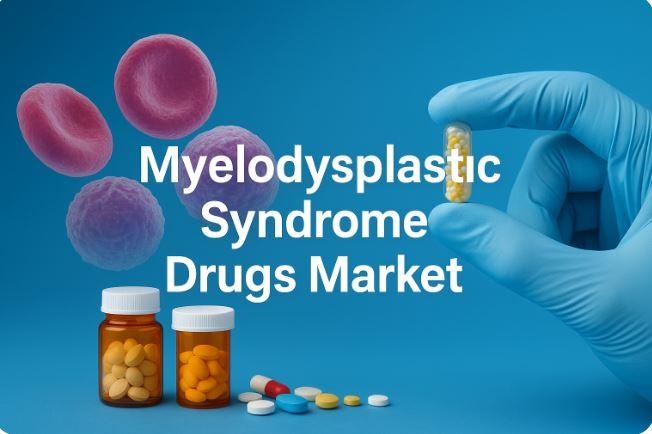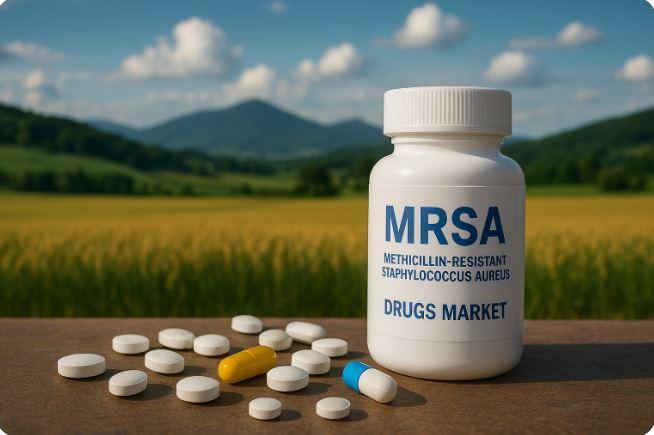Press release
Methicillin-Resistant Staphylococcus Aureus (MRSA) Drugs Market to Reach USD 3.29 billion by 2032, Growing at a CAGR of 5.11% says Credence Research
Market OverviewThe Methicillin-Resistant Staphylococcus Aureus (MRSA) Drugs Market plays a critical role in addressing drug-resistant bacterial infections, which pose a significant global health challenge. The market was valued at USD 2.21 billion in 2024 and is anticipated to reach USD 3.29 billion by 2032, reflecting a robust CAGR of 5.11% during the forecast period. MRSA remains one of the leading causes of hospital-acquired and community-acquired infections, necessitating effective pharmaceutical interventions.
The market's relevance has grown due to the rising prevalence of antibiotic-resistant infections, increased hospitalization rates, and the expanding global elderly population. The importance of MRSA drugs extends beyond healthcare settings, as community-acquired infections are on the rise, particularly in high-density urban regions. Advanced antibiotics, including glycopeptides, lipopeptides, oxazolidinones, and cephalosporins, have become essential in reducing mortality and improving patient outcomes.
Furthermore, technological advancements in drug development and ongoing clinical trials are accelerating the introduction of novel therapies. Increasing awareness among healthcare professionals about antibiotic stewardship and the need for targeted therapies also contributes to market expansion. With regulatory bodies streamlining approval processes for innovative MRSA drugs, the market is witnessing accelerated growth. As global healthcare systems increasingly prioritize combating antimicrobial resistance, MRSA drugs remain a crucial segment of the pharmaceutical market.
Preview the report with a detailed sample and understand how it can benefit your business strategy. Request a free sample https://www.credenceresearch.com/report/methicillin-resistant-staphylococcus-aureus-drugs-market
Market Drivers
Rising Prevalence of MRSA Infections
The increasing incidence of MRSA infections, both hospital-acquired (HA-MRSA) and community-acquired (CA-MRSA), is a primary driver of market growth. Recent studies indicate that MRSA accounts for a substantial proportion of bloodstream and skin infections globally, leading to increased demand for effective antibiotics. The rising prevalence has also led to longer hospital stays and higher treatment costs, pushing healthcare providers to prioritize effective therapies. Moreover, increasing awareness among patients and caregivers about MRSA risks has fueled early diagnosis and treatment adoption. With global urbanization and crowded healthcare settings, MRSA infections are projected to remain a pressing concern, further bolstering market demand.
Technological Advancements in Drug Development
Innovations in pharmaceutical formulations and novel drug classes, such as lipopeptides and oxazolidinones, are driving growth. Advanced delivery systems improve bioavailability and efficacy, enabling more efficient treatment of resistant bacterial strains. Additionally, ongoing research in combination therapies and next-generation antibiotics is expanding treatment options for complex infections. Improved drug design also minimizes adverse effects, encouraging higher adoption in both hospital and community settings. These technological breakthroughs are expected to accelerate new drug launches and enhance therapeutic outcomes, providing a competitive edge to leading pharmaceutical companies.
Rising Healthcare Expenditure
Governments and private healthcare providers are investing heavily in antimicrobial drugs to reduce MRSA-related complications. For instance, in North America, healthcare expenditure on antibiotic treatments has surged due to increasing hospitalization and infection management costs. Rising investment in specialized hospital units and diagnostic facilities further strengthens market potential. Public-private partnerships in healthcare infrastructure are also facilitating faster access to advanced treatments. Collectively, these investments support the introduction of innovative MRSA drugs, creating a sustainable environment for market growth.
Regulatory Support and Incentives
Regulatory agencies, such as the U.S. FDA, are facilitating faster approval for drugs targeting resistant infections. Incentives for pharmaceutical companies to develop advanced MRSA therapies have led to several new drug launches and ongoing clinical trials. Streamlined approval processes for breakthrough therapies encourage innovation and reduce time-to-market for critical treatments. Furthermore, global initiatives on antimicrobial stewardship highlight the importance of approved and effective MRSA drugs. These supportive policies are fostering a favorable ecosystem for continued market expansion.
Market Challenges
Antimicrobial Resistance
Growing bacterial resistance to existing MRSA drugs challenges the effectiveness of current treatments. Resistance increases the complexity and cost of treatment regimens, limiting market expansion. Overuse and misuse of antibiotics in both hospitals and communities exacerbate resistance patterns. Additionally, evolving MRSA strains require constant monitoring and development of new therapies. This dynamic environment demands continuous investment in research, making it a significant challenge for pharmaceutical companies.
High Development Costs
Developing new MRSA drugs involves significant R&D expenditure, clinical trials, and regulatory compliance costs. High investment requirements can deter smaller pharmaceutical companies from entering the market. Extended timelines for clinical validation and post-market surveillance further increase financial risk. Moreover, costs associated with scaling manufacturing for advanced drug classes can be prohibitive. As a result, only well-funded organizations with robust pipelines can consistently drive innovation in this market.
Stringent Regulatory Frameworks
While regulatory support exists, stringent requirements for clinical evidence, safety, and efficacy can delay drug approvals. Lengthy approval timelines affect time-to-market for new therapies. Compliance with evolving global standards for drug safety adds additional operational complexity. Pharmaceutical companies must also invest in extensive documentation and validation processes, which can slow product launches. These regulatory hurdles pose significant challenges to market agility and competitiveness.
Market Competition
The market faces intense competition from established pharmaceutical companies and emerging players. Price pressures and generic drug availability can limit profitability and hinder new market entrants. Additionally, competition drives companies to constantly innovate, increasing R&D expenses. Marketing and distribution strategies must also be adapted to maintain market share, particularly in regions with price-sensitive healthcare systems. This competitive environment requires strategic planning and continuous investment to sustain growth.
Market Opportunity
Emerging Drug Classes
The development of advanced antibiotic classes, including cephalosporins and glycopeptides, offers significant growth opportunities. These drugs address unmet medical needs for resistant infections. Novel formulations and combination therapies also open avenues for more effective treatment protocols. Continuous clinical research supports the introduction of next-generation antibiotics, increasing treatment success rates. As resistance patterns evolve, emerging drug classes are expected to drive future market expansion significantly.
Geographical Expansion
Emerging economies in Asia Pacific and Latin America present untapped market potential. Increasing healthcare infrastructure and rising awareness about antibiotic resistance are driving demand. Expanding hospital networks and rising government investment in public health programs enhance accessibility. Additionally, growing prevalence of MRSA in these regions creates a critical need for advanced therapies. These factors collectively offer significant opportunities for market growth in previously underserved regions.
Collaborations and Partnerships
Strategic alliances between pharmaceutical companies and research institutions facilitate knowledge sharing, accelerate drug development, and expand market reach globally. Partnerships also help in optimizing production and reducing development costs. Joint ventures can enable faster clinical trials and regulatory approvals. Collaborations with local healthcare providers in emerging markets further strengthen market penetration. These synergies create a supportive environment for innovation and commercialization of MRSA therapies.
Treatment of Complicated Infections
MRSA drugs targeting complex infections such as bacteremia and endocarditis provide opportunities for specialized therapy markets. Increasing prevalence of these conditions enhances demand for advanced treatments. Tailored therapeutic options for severe infections improve patient outcomes and reduce mortality rates. Hospitals and specialty clinics are more likely to adopt these innovative treatments, creating a niche market segment with high growth potential.
Market Segmentation
Based on Drug Class
• Glycopeptides
• Lipopeptides
• Oxazolidinones
• Cephalosporin
• Tetracycline
• Folate antagonist
Based on MRSA Type
• Hospital-acquired (HA-MRSA)
• Community-acquired (CA-MRSA)
Based on Indication
• Skin and soft tissue infections
• Bone & joint infections
• Respiratory infections
• Bacteremia
Based on Geography
North America
• U.S.
• Canada
• Mexico
Europe
• UK
• France
• Germany
• Italy
• Spain
• Russia
• Belgium
• Netherlands
• Austria
• Sweden
• Poland
• Denmark
• Switzerland
• Rest of Europe
Asia Pacific
• China
• Japan
• South Korea
• India
• Thailand
• Indonesia
• Vietnam
• Malaysia
• Philippines
• Taiwan
• Rest of Asia Pacific
Latin America
• Brazil
• Argentina
• Peru
• Chile
• Colombia
• Rest of Latin America
Middle East & Africa
• GCC Countries
• South Africa
• Rest of the Middle East and Africa
Regional Analysis
North America
North America holds a substantial share in the MRSA drugs market due to high prevalence of resistant infections and well-established healthcare infrastructure. The U.S. is the largest contributor, with increased hospitalizations and strong R&D investment driving market growth. Advanced diagnostic tools and widespread awareness programs support early detection and effective treatment. Moreover, robust reimbursement policies ensure access to high-cost MRSA drugs. Collectively, these factors consolidate North America's leadership in the global market.
Europe
Europe shows steady market expansion, with Germany, the UK, and France leading in MRSA drug consumption. Government initiatives to monitor antibiotic resistance and encourage novel drug adoption enhance market prospects. Growing investments in hospital infrastructure and healthcare workforce training further strengthen market demand. Additionally, collaborations between pharmaceutical companies and European research institutions support innovation and market penetration. These developments make Europe a consistently stable market for MRSA drugs.
Asia Pacific
Asia Pacific is an emerging market with rapid healthcare development. Countries like China, India, and Japan are witnessing rising MRSA incidence, increasing demand for effective therapies. Expanding hospital networks, rising disposable income, and growing urban population drive treatment adoption. Government programs focusing on infection control and antimicrobial stewardship also bolster market growth. These factors collectively make Asia Pacific one of the fastest-growing regions for MRSA drugs.
Latin America
Latin America is gradually adopting advanced MRSA treatments. Brazil and Argentina lead regional consumption, supported by increasing hospital capacity and rising healthcare expenditure. Growing awareness of drug-resistant infections and government initiatives for better healthcare infrastructure are key drivers. Additionally, partnerships between local hospitals and global pharmaceutical companies facilitate access to new therapies. These dynamics position Latin America as an emerging market with significant growth potential.
Middle East & Africa
The Middle East & Africa region exhibits growth potential due to rising infections and improving healthcare access. GCC countries and South Africa are key markets driven by increasing demand for advanced antibacterial drugs. Expanding hospital infrastructure and government support for public health programs further enhance adoption. Additionally, rising awareness among healthcare professionals about MRSA management contributes to market growth. Collectively, these factors position the region as a promising market for pharmaceutical companies.
Top Companies
• Pfizer Inc.
• Novartis AG
• AbbVie Inc.
• Teva Pharmaceutical Industries Ltd.
• Johnson & Johnson
• Cumberland Pharmaceuticals Inc
Recent Developments
• In 2025, Innoviva Specialty Therapeutics made ZEVTERA (ceftobiprole medocaril sodium for injection) commercially available in the U.S., the first approved advanced-generation cephalosporin for MRSA bacteremia, including endocarditis.
• In February 2025, AbbVie Inc. and Pfizer Inc. received U.S. FDA approval for Emblaveo to treat complicated intra-abdominal infections, including those caused by drug-resistant bacteria.
• In April 2024, Basilea Pharmaceutica Ltd.'s Zevtera (ceftobiprole) earned U.S. FDA approval, providing an additional option for MRSA-related bloodstream infections.
Reasons to Purchase this Report:
• Gain in-depth insights into the market through both qualitative and quantitative analyses, incorporating economic and non-economic factors, with detailed segmentation and sub-segmentation by market value (USD Billion).
• Identify the fastest-growing regions and leading segments through analysis of geographic consumption trends and the key drivers or restraints affecting each market.
• Track the competitive landscape with updated rankings, recent product launches, strategic partnerships, business expansions, and acquisitions over the past five years.
• Access comprehensive profiles of key players, featuring company overviews, strategic insights, product benchmarking, and SWOT analyses to assess market positioning and competitive advantages.
• Explore current and projected market trends, including growth opportunities, key drivers, challenges, and limitations across developed and emerging economies.
• Leverage Porter's Five Forces analysis and Value Chain insights to evaluate competitive dynamics and market structure.
• Understand how the market is evolving and uncover future growth opportunities and emerging trends shaping the industry.
Related Reports -
Specialty Pharmaceuticals Market: https://www.credenceresearch.com/report/specialty-pharmaceuticals-market
Whole Genome Sequencing Market: https://www.credenceresearch.com/report/whole-genome-sequencing-market
Follow Us:
https://www.linkedin.com/company/credenceresearch/
https://www.facebook.com/CredenceResearch
Credence Research Europe LTD - 128 City Road, London, EC1V 2NX, UNITED KINGDOM
Credence Research is a viable intelligence and market research platform that provides quantitative B2B research to more than 2000 clients worldwide and is built on the Give principle. The company is a market research and consulting firm serving governments, non-legislative associations, non-profit organizations, and various organizations worldwide. We help our clients improve their execution in a lasting way and understand their most imperative objectives.
This release was published on openPR.
Permanent link to this press release:
Copy
Please set a link in the press area of your homepage to this press release on openPR. openPR disclaims liability for any content contained in this release.
You can edit or delete your press release Methicillin-Resistant Staphylococcus Aureus (MRSA) Drugs Market to Reach USD 3.29 billion by 2032, Growing at a CAGR of 5.11% says Credence Research here
News-ID: 4209884 • Views: …
More Releases from Credence Research Inc.

Myelodysplastic Syndrome Drugs Market to Reach USD 2,057.7 million by 2032, Grow …
Market Overview
The Myelodysplastic Syndrome Drugs Market size was valued at USD 1,120 million in 2024 and is anticipated to reach USD 2,057.7 million by 2032, at a CAGR of 7.9% during the forecast period (2024-2032). Myelodysplastic syndromes (MDS) represent a group of hematologic disorders characterized by ineffective hematopoiesis, leading to abnormal blood cell formation and increased risk of acute myeloid leukemia. The rising prevalence of these syndromes among the aging…

Aluminum Honeycomb Core Market to Reach USD 3,446.92 million by 2032, Growing at …
Market Overview
The Global Aluminum Honeycomb Core Market size was valued at USD 1,282.78 million in 2018, expanding to USD 1,960.93 million in 2024, and is projected to reach USD 3,446.92 million by 2032, registering a CAGR of 6.80% during the forecast period. This consistent growth reflects the increasing demand for lightweight, high-strength materials across various industries, including aerospace, automotive, and construction. The aluminum honeycomb core's unique hexagonal structure offers superior…

Braze Alloys Market to Reach USD ,392.65 million by 2032, Growing at a CAGR of 3 …
Market Overview
The Global Braze Alloys Market size was valued at USD 1,870.07 million in 2018, reaching USD 2,432.24 million in 2024, and is anticipated to attain USD 3,392.65 million by 2032, growing at a CAGR of 3.95% during the forecast period. Braze alloys play a critical role in joining dissimilar materials with precision and durability, which makes them indispensable across a range of industries including automotive, aerospace, electronics, and construction.…

Aluminium Ingots Market to Reach USD 156,044.1 million by 2032, Growing at a CAG …
Market Overview
The Aluminium Ingots Market is projected to grow from USD 106,425 million in 2024 to USD 156,044.1 million by 2032, registering a CAGR of 4.9% during the forecast period. This steady expansion reflects aluminium's central role across industries such as construction, automotive, aerospace, and consumer goods. Aluminium ingots serve as a foundational raw material used in casting, rolling, and extrusion processes for manufacturing a variety of products, from vehicle…
More Releases for MRSA
Mrsa Drugs Market Size, Share, Forecast Report 2025-2034
The MRSA Drugs Market Is Set To Grow At An Estimated CAGR Of 6.5% From 2025 To 2034, Rising From $6.8 Billion In 2024 To $11 Billion By 2034.
On April 29, 2025, Exactitude Consultancy., Ltd. released a research report offers a comprehensive examination of the various processes and materials used in the production of Mrsa Drugs market goods. The market study excludes key regions that are accelerating marketization. This section…
Combating MRSA with Cutting-Edge Pharmaceutical Advances
"The Business Research Company recently released a comprehensive report on the Global Methicillin-Resistant Staphylococcus Aureus (MRSA) Drugs Market Size and Trends Analysis with Forecast 2024-2033. This latest market research report offers a wealth of valuable insights and data, including global market size, regional shares, and competitor market share. Additionally, it covers current trends, future opportunities, and essential data for success in the industry.
According to The Business Research Company's, The methicillin-resistant…
MRSA Antibiotics Market Analysis, Size, Current Scenario and Future Prospects
MRSA Antibiotics Market was estimated at US$ billion in 2023 and is predicted to reach US$ billion by 2029 with sales revenue expected to register CAGR of 4.3% over the forecast period. Rising number of surgical conditions from chronic diseases such as diabetes, chronic respiratory and renal diseases are expected to increase the demand of post-operative MRSA anti-infective therapies.
Important changes in the business allow key players to attain larger profits.…
VRE and MRSA Antibiotic Market 2021 | Detailed Report
According to Market Study Report, VRE and MRSA Antibiotic Market provides a comprehensive analysis of the VRE and MRSA Antibiotic Market segments, including their dynamics, size, growth, regulatory requirements, competitive landscape, and emerging opportunities of global industry. An exclusive data offered in this report is collected by research and industry experts team.
Get Free Sample PDF (including full TOC, Tables and Figures) of VRE and MRSA Antibiotic Market @ https://www.reportsnreports.com/contacts/requestsample.aspx?name=4645656
The…
MRSA Testing Market Analysis of Top industry Scenario
Global MRSA Testing Market report it provides a vital recent industry data which covers in general market situation along with future scenario for industry around the Globe. It also consists of major data along with forecasts of a global market along with clear presentation of diagrams (charts and tables).
According to a new report published by Allied Market Research, titled, "Global MRSA Testing Market by Type (Immunodiagnostics and Molecular Diagnostics) By…
Find out Why MRSA Antibiotics Market Is Thriving Worldwide
A new market study on Global (United States, European Union and China) MRSA Antibiotics Market with 100+ market data Tables, Pie Chart & Graphs is released that will provide complete assessment of the Market and covers evolving trends, current scenario analysis and growth factors, and industry validated market data. The research study provides market breakdown by revenue and volume (if applicable) and price history estimates for Global (United States, European…
